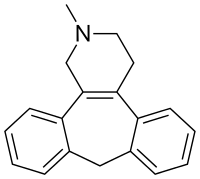Setiptiline
Setiptiline (brand name Tecipul), also known as teciptiline, is a tetracyclic antidepressant (TeCA) which acts as a noradrenergic and specific serotonergic antidepressant (NaSSA). It was launched in 1989 for the treatment of depression in Japan by Mochida.[1][2]
 | |
| Clinical data | |
|---|---|
| Trade names | Tecipul |
| Other names | Teciptiline; delta(13b,4a),4a-Carba-mianserin; MO-8282; ORG-8282 |
| AHFS/Drugs.com | International Drug Names |
| Routes of administration | Oral |
| ATC code |
|
| Legal status | |
| Legal status |
|
| Identifiers | |
IUPAC name
| |
| CAS Number | |
| PubChem CID | |
| DrugBank |
|
| ChemSpider |
|
| UNII | |
| KEGG |
|
| CompTox Dashboard (EPA) | |
| ECHA InfoCard | 100.055.123 |
| Chemical and physical data | |
| Formula | C19H19N |
| Molar mass | 261.36 g/mol g·mol−1 |
| 3D model (JSmol) | |
SMILES
| |
InChI
| |
| | |
Pharmacology
Pharmacodynamics
| Site | Ki (nM) | Species | Ref |
|---|---|---|---|
| SERT | >10,000 (IC50) | Rat | [4] |
| NET | 220 (IC50) | Rat | [4] |
| DAT | >10,000 (IC50) | Rat | [4] |
| 5-HT1A | ND | ND | ND |
| 5-HT2A | ND | ND | ND |
| 5-HT2C | ND | ND | ND |
| α1 | ND | ND | ND |
| α2 | 24.3 (IC50) | Rat | [5] |
| H1 | ND | ND | ND |
| mACh | ND | ND | ND |
| Values are Ki (nM), unless otherwise noted. The smaller the value, the more strongly the drug binds to the site. | |||
Setiptiline acts as a norepinephrine reuptake inhibitor,[4] α2-adrenergic receptor antagonist,[5] and serotonin receptor antagonist,[6] likely at the 5-HT2 subtypes, as well as an H1 receptor inverse agonist/antihistamine.[4]
Chemistry
Setiptiline has a tetracyclic structure and is a close analogue of mianserin and mirtazapine, with setiptiline being delta(13b,4a),4a-carba-mianserin, and mirtazapine being 6-azamianserin.
See also
References
- Buschmann, H.; Torrens, A.; Vela, J. M. (2007). Antidepressants, Antipsychotics, Anxiolytics: From Chemistry and Pharmacology to Clinical Application. 1. Wiley VCH. p. 248. ISBN 978-3-527-31058-6.
- Swiss Pharmaceutical Society, ed. (2000). Index Nominum 2000: International Drug Directory. Medpharm Scientific Publishers. p. 942. ISBN 3-88763-075-0.
- Roth, BL; Driscol, J. "PDSP Ki Database". Psychoactive Drug Screening Program (PDSP). University of North Carolina at Chapel Hill and the United States National Institute of Mental Health. Retrieved 14 August 2017.
- Niho T, Ito C, Shibutani Y, Hashizume H, Yamaguchi K (1986). "[Pharmacological properties of MO-8282, a novel antidepressant]". Nippon Yakurigaku Zasshi (in Japanese). 88 (4): 309–20. PMID 3792961.
- Mizota M, Oikawa Y, Nakayama K, Mizuguchi K, Takarada T, Kojima M, Kanehiro H, Funato H, Kayamoto M, Sato M (1986). "[Pharmacological studies of MO-8282, a new antidepressant]". Nippon Yakurigaku Zasshi (in Japanese). 88 (6): 457–66. PMID 2881854.
- Przegaliński E, Baran L, Siwanowicz J, Rawłów A (1986). "The lack of antidepressant properties and a potent central antiserotonin activity of Org 8282". Pol J Pharmacol Pharm. 38 (4): 377–84. PMID 3774630.
| 5-HT1AR agonists | |
|---|---|
| GABAAR PAMs |
|
| Gabapentinoids (α2δ VDCC blockers) | |
| Antidepressants |
|
| Sympatholytics (Antiadrenergics) |
|
| Others | |
| |
| |||||||||||||||||||||||||||||||||||||||||||||||||||||||||||||||||||||||||||||||||||||||||||||||||||||||||||||||||||||||||||||||||||||||||||||||||||||||||||||||||||||||||||||||||
| Classes |
|
|---|---|
| Antidepressants (TCAs and TeCAs) |
|
| Antihistamines |
|
| Antipsychotics |
|
| Anticonvulsants | |
| Others |
|
This article is issued from
Wikipedia.
The text is licensed under Creative
Commons - Attribution - Sharealike.
Additional terms may apply for the media files.